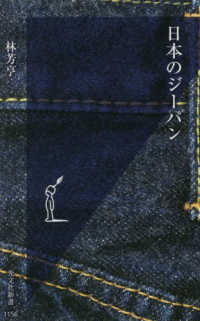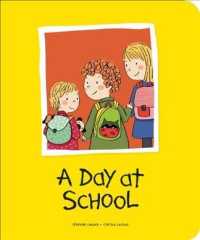Full Description
This book edition offers a collection of scholarship and reflections that goes beyond theoretical conversations. This volume helps reignite a dialogue not only by scholars but also by educators, activists, and students who believe in inclusive and equal access to education for all individuals regardless of race, ethnicity, immigration status, gender, sexuality, religion, and other identities. In this volume, the authors examine curriculum and pedagogy as a tool for recovery from political trauma and healing. They used thisas an opportunity to confront some of the politically shameful situations affecting educational environments, homes, neighborhoods, enclaves, and regions marked by socioeconomic inequality.
The authors of Making a Spectacle present wide-open questions: How are educators and school leaders learning to interact with one another, students, their families, and community while facing increased mass school shootings, police violence, racial profiling, unequal access to education and basic needs during a pandemic (COVID-19), and other forms of sociopolitical stress influenced by discrimination, institutional racism, and White nationalism? What curricular and pedagogical geographies are educators and students afforded through which to process their emotional responses to ecological or political activities witnessed in schools and their surrounding areas? These chapters and reflections/perspectives represent a diversity of positionalities within critical intersections of power and privilege as they relate to identity, culture, and curriculum and social justice, schools, and society.
Contents
Introduction.
Section I. Recovery From Political Trauma Through Resistance.
Chapter 1. Performing Nepantla: Spanglish as Visual Art Practice in the Rio Grande Valley Borderlands; Joellyn Sanchez, Ivan Cantu, Monica Varela, Maricela Casas, Maritzabel Salinas and Christen Sperry García.
Chapter 2. Reflecting Back; Kelly P. Staniunas.
Chapter 3. Living Art Out Loud: Performances at the Texas Tech University Public Art Collection; G. Dean McBride.
Chapter 4. Pluribus vs. Unum as Values in Citizenship Education; Eleni Mousena.
Section II. Issues Surrounding American Gun Violence And Its Normalization In Schools.
Chapter 5. Only a Drill; Emily Marie Passos Duffy.
Chapter 6. Caught in the Political Machine: Educators and Active-Shooter Drills; Jessica O'Brien and Vonzell Agosto.
Chapter 7. so used to trauma, so calm; Samuel J. Tanner.
Chapter 8. Grant, Martin, Garner, Rice, and Teaching On; Brian Gibbs.
Section III. Healing Political Trauma Through Art Expression.
Chapter 9. Restorative (Re) Creation(s): Releasing Thoughts and Perspectives Through Counter-Cartography; Bretton A. Varga and Kiara Flores.
Chapter 10. When the Airborne Toxic Event Broke New Orleans' Levees; David R. Fisher.
Chapter 11. The Critical, Posthumanities as a Lens for Curriculum Theorizing: Trauma-Informed Curriculum in a More-Than-Human, More-Than-Critical World; Mary Newbery.
Section IV. Lived Experiences With Political Trauma Survivors.
Chapter 12. Reflection: Recently Arrived—Still Under-Served: Language Learning and Teaching in the Shadows; Michelle Angelo-Rocha, Lisa Armstrong, Ann Marie Mobley, and Dionne Davis.
Chapter 13. Intentional Caregiving Through Love and Cariño: Mixed Status Families Responding to Issues of ICE and Im/migration; Larisa Callaway-Cole.
Chapter 14. Reflection: A Testimonio of Political Trauma: Coyote Meets His Match; Paul Perez-Jimenez.
Chapter 15. Patrick Stays Silent: East African Refugee Transition in American Education; Michaela Inks.
Chapter 16. Reflection: Forced Normalcy as Political Trauma for Students With Disabilities; Caitlin Sweetapple.
Chapter 17. Reflection: Parent Cafe Reflections; Matthew Bradley and Maura Sellars.
Section V. Political Aftermath And Creating Space For Recovery/Healing.
Chapter 18. Neutrality as Lightning Rod: Contextualizing Teachers' Experiences in the 2016 Election Aftermath; Erin Dyke, Jinan El Sabbagh, Sarah Gordon, and Jennifer Job.
Chapter 19. Make America Great for Once (MAGFO); Chantae D. Still.
Chapter 20. Renegade Teachers: Deconstructing Heteronormative Narratives in the Classroom; Mark Hickey, Jinan El Sabbagh, and Megan Ruby.
Chapter 21. Reflection: Sisyphus With a Smile: On Finding Momentum Through Political Trauma in Education; Nadia Khan-Roopnarine.
Chapter 22. We Are Still Here: (Not) Teaching Disruption, Interruption, Resistance, and the Creation of Change; Brian Gibbs and Kristin Papoi.
Chapter 23. Society's Gate Keepers; Jose Cordon.
Section VI. More Than A Label: Empowerment In Creating Space In Higher Education.
Chapter 24. Black Academic Resistance: A Visual Arts Approach to Empirical Research; Asha Omar.
Chapter 25. A Mirror; Sarrah Grubb.
Chapter 26. Reflection: Inertia and Pa'delante; Freyca Calderon-Berumen and Miryam Espinosa-Dulanto.
About the Contributors.







